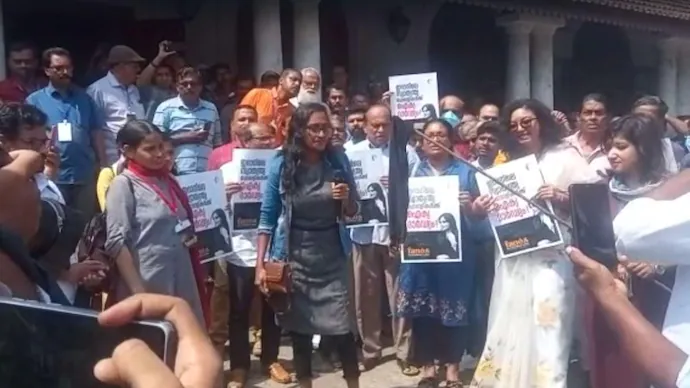Kerala women burning progressive hijabs by choice


Muslim women in Kerala burned their hijabs on November 6 to show their support for the anti-hijab campaign in Iran. The incident involving the burning of the hijab happened at a Kerala Yukthivadi Sangam seminar titled “Fanos-Science and Free Thought” in Kozhikode.
Six women participated in the event by burning a hijab in support of Iranian women who are protesting the tight regulations on the veil’s wear imposed by the Islamic theocracy.
According to reports, this is the first instance of its kind to be reported in India, where a hijab was burned to show support for women protesting the death of Mahsa Amini, an Iranian woman whose death after being detained by “morality police” sparked the largest uprising in the Islamic nation in decades.
The organization’s members waved signs and shouted chants in support of Iranian women protesting the compulsory headscarf. The organization is renowned for hosting free-thinking-focused lectures.
Meanwhile, the seculars in India want to legitimize the Islamic headdress while Iranian women resist hijab imposition by setting fire to their headscarves. Mahsa Amini, 22, was recently murdered in Iran by “morality police” for wearing an “improper” headscarf.
Amid the hijab controversy in recent months, members of the leftist-secular cabal made an effort to defend the backward Islamist practice, not just in Congress. Leftists frequently make erroneous comparisons between the ghoonghat and the hijab, claiming that the former is a cultural practice that is not worn all the time, while the latter is imposed on a gender. It is evident from the fact that, in contrast to Iranian Islamists who murdered Mahsa Amini for improperly donning the hijab, no Hindu woman has ever perished for failing to wear the ghoonghat.
By equating the circumstances in Iran and India, the left thinks it is showing some kind of bravery and challenging “patriarchy,” but in reality, it is comparing apples and oranges.
Mahsa Amini, 22, died on September 16 after being attacked because her hijab did not cover her hair. On September 13, after being beaten inside a police van and a detention facility, she was admitted to a hospital. She was reportedly brain-dead after slipping into a coma.
Iran has seen protests after Mahsa Amini’s murder, with women removing their hijabs to voice their opposition to moral policing. In protest of the murder of Mahsa Amini, a 22-year-old woman by hijab police, women in Iran-Saghez took off their head coverings and chanted, ‘Death to the dictator!’ In Iran, taking off the headscarf is a crime.
On the other hand, in India, a controversy arose when pupils were asked to abide by uniform norms and the Islamic headscarf was outlawed in schools in Karnataka state. The anti-Hindu PFI and its student wing CFI are accused of starting the argument by “counseling” girls to wear the hijab in class, which is against the rules regarding uniforms.
Even the Karnataka High Court (HC) had ruled that wearing a uniform in schools and colleges is a legitimate restriction on the right to follow one’s religion and that it is not an essential practice in Islam. This does not prevent Muslim women from making their choice in public or on the street. The arguments in the HC highlighted case law demonstrating that it is not required.
DISCLAIMER: The author is solely responsible for the views expressed in this article. The author carries the responsibility for citing and/or licensing of images utilized within the text.
